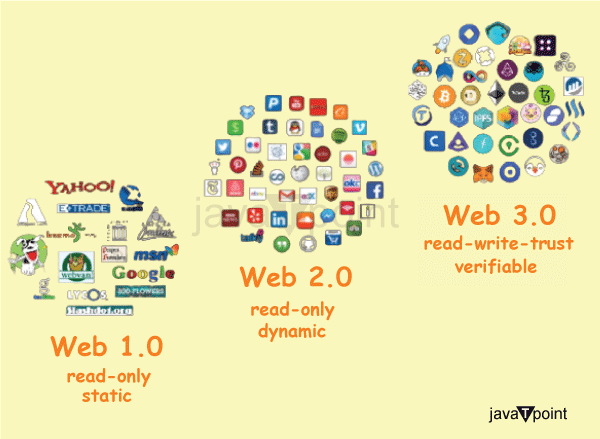Top web 3.0 benefitsSince its debut in the first decade of the 1990s, the World Wide Web has grown to become an essential part of our everyday lives. At the same time, the technologies, systems, and protocols that enable the internet have been fast evolving. As a result, customer web experiences have changed dramatically. As the world continues to migrate towards web 3, here is a spike in interest in top web 3.0 features and benefits. The Road to Web3
The simplest method to find the major web 3.0 benefits is to initially comprehend how web3 ended up be. In its early phases, known as web 1.0, the world of the web was consisted of static websites that offered information or completed activities such as ticket purchase. There was no means for consumers to connect to the Internet. Then emerged web 2.0, featuring the concept of user-generated content and the sporadic emergence of online commerce and platforms for social networking. The second phase of the internet allows users to create material, upload it on the global web, and afterwards share it with others. The Web 2.0 paradigm, on the other moment, has a significant disadvantage in the form of IT corporations functioning as consolidated authority over data access and ownership. The top web3 benefits aim to solve the problems of web2, which relies primarily around centralised technologies and servers. Furthermore, web 2.0 is plagued by numerous important issues in self-sovereign identity, online security, and data transfer. What exactly is Web 3.0?The one issue that is core to every web3 debate now has significant repercussions. Web 3.0 is a new word that everyone can decode based on their understanding. To begin, you must be aware that web3 benefits are focused on addressing some of the more prominent and critical difficulties in today's web world. There's no centralised body in charge of the creation of web3 as the supervisor. On the contrary, web3 development success is based on a varied mix of commercial enterprises, individuals, and non-profit organisations. Because web 3 is still in its early stages, a comprehensive description is hard to offer. Consider it the internet's third generation, with decentralised governance, transparency, plus user autonomy. The basic idea of web3 serves as a strong basis for understanding its benefits. Web3 Advantages
The fundamental review of the path to web3 and its definition indicate how critical it is currently. Furthermore, the features of web3 revealed a glimpse of its ability to change the internet or customer experiences. You may evaluate the primary benefits of web3 based on the findings reached regarding web3 foundations. These represent a few of the more significant advantages of web3 that everyone should be aware of. Ownership of Data ControlConsider all of the websites and online tools you use on a regular basis. You offer your personal information on several platforms to obtain access to various services. You create material, such as photographs or videos, and share it on social media networks such as Facebook and Instagram. In the middle of all of this, you must have felt that the confidential data on an Amazon account or the photographs on your Facebook profile were securely stored under your control. That is not the case, since centralised businesses such as Amazon, Facebook, and Google utilise a variety of tactics to commercialise information about customers. Because of the benefits of web3 by design, customers would have total control over the data they hold. Users might collaborate based on their preferences. Web3 may benefit from breaking the tech titans' grasp on user data. Widespread Access to DataThe interconnectivity characteristic of web 3.0 also contributes significantly to a big web 3.0 advantage. The fundamental component of Web3 would be the creation of a networked environment that allows for information interoperability and accessibility. On the other side, IoT connectivity would provide ubiquitous data access, which is one of the most significant web3 benefits. Users may access information from any device, from any location. Web3 may allow you to connect to the internet even if the way you are without a computer or smartphone. Independence in InteractionsA list of the greatest web 3.0 features would include its contribution to ensuring seamless user interactions. Because Web3 is based on blockchain's permissionless characteristic, there is no one body in charge of managing user access. Web3 apps based on open distributed ledgers may aid in ensuring that web3 is accessible to everybody. Location, social status, sexual orientation, age, or poverty would not be barriers to accessing digital services. With the help of web3's core design, users may move digital property, wealth, or data more rapidly and effectively over the world. Because there does not exist central authority over the transactions, Web3 allows internet users to take full advantage of the web's capabilities. Benefits to CreatorsBecause of the arrival of web3, all content providers now have a fantastic chance. The bulk of content creators struggle to obtain the true value for their labour due to the middlemen in the various means of reaching their audience. The key web 3.0 aspects of tokenization when possible and the creative sector may benefit creators greatly. Greater SafetyThe last the most important benefit provided under web 3 is the promise of better security. Blockchain technology may offer decentralisation and encryption to safeguard user data. Because of its consensus mechanisms and core nature, blockchain is impervious to traditional security problems. While 51% of attacks may still be utilised to harm web3 apps including systems, developing new safety procedures and best practises may resolve the vulnerabilities. First and foremost, Web3 would ensure decentralised authority over security of digital assets such like as tokens and data. On the other hand, creators would have complete control over who owns what they have created. The economy of creation may also help creators find new resources and marketplaces to expand their audience. Infrastructure for the semantic web's foundationsThe "semantic web" is a key component of Web 3.0. Tim Berners-Lee used the concept to describe a network containing information that computers can study. The study of the way facts are understood or emotionally tinged is known as semantics. Search and assessment will aid in the development, communication, and connecting of material, as well as the comprehension of word meanings. Semantic metadata will stimulate higher data transfer in Web 3.0. As a consequence, the user experience rises to a greater degree of connection, utilising all available data. The semantic network will assist in training the computer to grasp what the data truly means, allowing machine learning to produce practical applications that more efficiently use the data. Using artificial intelligence (AI) exclusivelyArtificial intelligence is the second primary technical driver driving Web 3.0 (AI). AI has progressed to the point where it can make proactive, relevant, and useful predictions and assessments. AI powers several of the more popular Web 3.0 features. For example, the semantic web aims to enable individuals as well as machines to connect with one another using text, voice, and other interfaces. "Natural speech processing" (NLP) is an area of computer science that allows machines to interpret both written and spoken languages. Unlike previous applications such as grammar check and auto-complete, Linguistics employs advanced algorithms to enable robots to read, interpret, and infer the deeper implications of words and phrases. The intersection of AI, natural language processing, plus the semantic web as technological advances. Possible difficulties to recallWeb 3.0, or Web 4.0, is a revolutionary new way to use online resources that offers several advantages over standard web sites. These improvements include better navigation, quicker load times, as well as greater security and privacy. However, the risks and hazards offered by the internet remain quite real. In a decentralised website system, government participation will be more difficult. Deception, disinformation, and hate speech may be difficult to control and avoid in the absence of centralised platforms. In addition, unlike Web 2.0, company structures will evolve to include more decentralised components. Relations with governments will be difficult on a distributed system since activity will span geographical boundaries. Disputes may be subject to the rules of many nations. ConclusionWeb 3.0 is currently under development and is expected to be released in the future years. When paired with technologies like as the the metaverse, augmented and virtual reality (AR), blockchain, and cryptocurrency, it has the potential to drastically revolutionise how we browse online and communicate with the rest of the world.
Next TopicHow to Convert Word to HTML
|
 For Videos Join Our Youtube Channel: Join Now
For Videos Join Our Youtube Channel: Join Now
Feedback
- Send your Feedback to [email protected]
Help Others, Please Share










